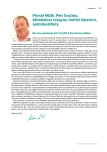The imaging of musculoskeletal manifestations and complications in diabetes mellitus
Authors:
Jindra Brtková
Authors‘ workplace:
Radiologická klinika LF UK a FN Hradec Králové, přednosta prof. MUDr. Antonín Krajina, CSc.
Published in:
Vnitř Lék 2015; 61(6): 552-558
Category:
Předneseno na mezioborovém sympoziu s postgraduálním zaměřením „Diabetik – společný pacient diabetologa a ortopeda“ 10. října 2014 v Hradci Králové.
Overview
The musculoskeletal system is one of the major regions, where changes caused by diabetes mellitus (DM) are often encountered causing severe impairment of the quality of patients´ lives. These changes have therefore become an important focus of diagnostic and therapeutic procedures, with imaging methods – both plain radiography, computed tomography (CT), magnetic resonance imaging (MRI) and to a lesser extent ultrasound (US), being their cornerstones. In the article the images of musculoskeletal (MSK) manifestations of diabetes mellitus are presented, structured into changes directly caused by DM, metabolic consequences of DM, syndromes with increased coincidence with DM and septic complications. The CT, MRI and radiographic images of both initial and extensive changes are being displayed as well as evolution of the changes in a radiographic series. The concerning pathophysiologic remarks are only basic, as they are not the primary focus of radiodiagnostics. In conclusion it is stated, that imaging of the MSK system in diabetic patients is a large issue in radiologic units serving internal medicine departments, that the imaging methods should be applied specifically and that the radiologic findings influence further management of the patients in many respects, but also, that in some diagnostic questions, namely concerning septic complications of the diabetic foot, a fully reliable and unequivocal interpretation is not always possible.
Key words:
diabetes mellitus – imaging – musculoskeletal system
Sources
1. Attar SM. Musculoskeletal manifestations in diabetic patients at a tertiary center. Libyan J Med 2012; 7: 19162. Dostupné z DOI: <http://dx.doi.org/10.3402/ljm.v7i0.19162>.
2. Gouveri E, Papanas N. Charcot osteoarthropathy in diabetes: A brief review with an emphasis on clinical practice. World J Diabetes 2011; 2(5): 59–65.
3. Schlossbauer T, Mioc T, Sommerey S et al. Magnetic resonance imaging in early stage Charcot arthropathy: correlation of imaging findings and clinical symptoms. Eur J Med Res 2008; 13(9): 409–414.
4. Chantelau EA, Grützner G. Is the Eichenholtz classification still valid for the diabetic Charcot foot? Swiss Med Wkly 2014; 144:w13948. Dostupné z DOI: <http://dx.doi.org/ 10.4414/smw.2014.13948>.
5. Baker JC, Demertzis JL, Rhodes NG et al. Diabetic musculoskeletal complications and their imaging mimics. Radiographics 2012; 32(7): 1959–1974.
6. Kim RP, Edelman SV, Kim DD. Musculoskeletal complications of diabetes mellitus. Clinical Diabetes 2001; 19(3): 132–135.
7. Zampa V, Barellini I, Rizzo L et al. Role of dynamic MRI in the follow-up of acute Charcot foot in patients with diabetes mellitus. Skeletal Radiol 2011; 40(8): 991–999.
Labels
Diabetology Endocrinology Internal medicineArticle was published in
Internal Medicine

2015 Issue 6
Most read in this issue
- Diagnosing and therapy of gout
- Alveolar echinococcosis – rare cystic disease of the liver – editorial
- Guidelines of Czech Association for Thrombosis and Haemostasis of the Czech Medical Association of J. E. Purkyně for safety treatment with new oral anticoagulants (NOAC) – dabigatran etexilate, apixaban and rivaroxaban
- “Stressful holiday” – takotsubo cardiomyopathy
